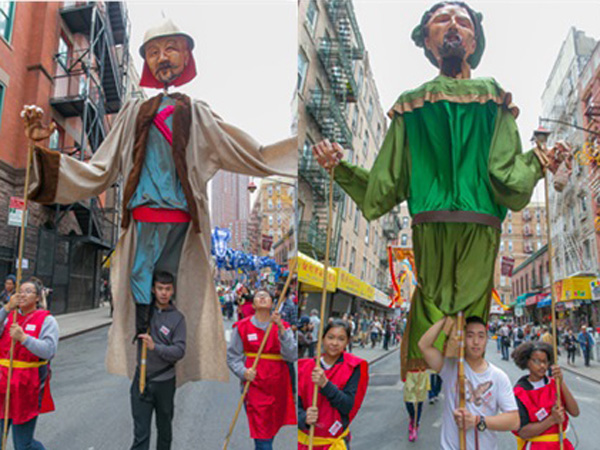New York’s Chinatown, Little Italy celebrated together in Marco Polo Festival
By William Hennelly (China Daily USA) Updated: 2015-10-15 23:07
|
 |
|
Marionettes depicting Kublai Khan (left) and Marco Polo are hoisted on Mulberry Street in Manhattan during the Marco Polo Festival in October 2014. PROVIDED TO CHINA DAILY |

The event, sponsored by the Two Bridges Neighborhood Council, a community organization founded in 1955, celebrates the living history of Manhattan’s Chinatown and Little Italy, which are longtime neighbors in one of New York’s oldest and most picturesque areas.
“Every year it grows in scale and also in popularity,” Elisa Rae Espiritu, director of development and communications for Two Bridges, told China Daily.
The festivities begin at 11 am on Mott Street with a procession up Mulberry Street to Grand Street. Fifteen-foot-tall marionettes depicting Marco Polo and Kublai Khan and a hand-painted 50-foot silk banner of the Silk Road are hoisted through the streets by local youth, accompanied by musicians.
“This is the first year that the procession is going to be choreographed,” Espiritu said, noting that four rehearsals have been held.
The festival took on added meaning in 2009, when Two Bridges sponsored the designation of the Chinatown and Little Italy Historic District to the National Register of Historic Places, an honor that the neighborhood was granted in February 2010.
The event was the idea of Two Bridges President Victor Papa, who came up with Marco Polo as the “overall theme and metaphor to best explain the two communities coinciding”, Espiritu said.
Marco Polo was a Venetian merchant traveler in the 1200s. He, his father Niccolo and uncle Matteo embarked on a 24-year journey through Asia starting in 1269, where they met Khan in an area that is now Beijing. Khan, the first emperor of the Yuan Dynasty (1271-1368), had an interest in the European legal and political system and asked them to deliver a letter to the pope.
Khan and Polo could be considered the spiritual grand marshals of the festival, which includes some intricately designed props.
“Back in 2010, we worked very closely with the official puppeteers of the West Village Halloween parade: Processional Arts Workshop,” Espiritu said. … “They designed for us a series of large-scale marionette puppets.”
The procession will arrive at the Grand Street Stage at 11:30 am, where a mixture of music and cultural performances will start.
Denis Belliveau, a photographer, author and explorer, will host a pop-up Silk Road Museum on Grand Street, featuring artifacts that he collected in China and that were featured in his 2008 Emmy Award-nominated documentary In the Footsteps of Marco Polo.
The artifacts will be displayed in a Yurt tent and will include antique gowns from Central Asia and China, silkworm cocoons and an Afghan horse crop made of sheep bone that was given to Belliveau by the shah of the Wakhan Corridor.
The show also will include traditional Chinese and Italian opera, folk dances, and contemporary Chinese and Italian instrumental performances and acrobatics.
When Two Bridges was founded 60 years ago in the neighborhood bordered by the Brooklyn and Manhattan bridges and the East River, tensions were high, with gang violence common, the group’s website says. The area also was becoming one of the city's first integrated neighborhoods. Two Bridges was created to resolve racial conflicts and to foster communication among settlement houses, churches and community leaders.
In the 1960s, Two Bridges’ focus turned to community planning, when AT&T wanted to demolish a block of residential houses on Madison Street to make way for a telephone switching station, which would have forced hundreds of low-income families from their homes. Two Bridges hired a social worker, organized the community and worked out a plan to save the houses by getting the switching station moved to a non-residential location.
By the early 1970s, Two Bridges’ mission evolved to one of neighborhood preservation and affordable housing. In 1972, the organization co-sponsored the redevelopment of the Two Bridges Urban Renewal Area, formerly an area of tenements and dilapidated commercial buildings along the East River between the Manhattan Bridge and Corlears Hook.
“Part of the commitment we have is to figure out how we can help the public learn about how these two communities have harmoniously coincided for many years,” Espiritu said. “We’re trying to do our best to reference the living history of the area as well as celebrate it.”
Contact the writer at williamhennelly@chinadailyusa.com




